The alarm went off at 6:30am this morning; by 7:15am we were sitting in the lobby of our hotel waiting for Neville Dean to show up. He's a garrulous Australian entrepreneur who "retired" to Hoi An a few years ago with his "long-suffering wife Colleen" (that's how he always refers to her) to live out the rest of his days in this tropical paradise eating some of the best food on the planet. For a hard-core foodie like Neville, you see, so this place is basically Shangri La. He spends his days exploring the markets and restaurants around town and showing them off to friends of his who visit -- and also to total strangers, like us, who manage to snag a spot in one of his organized "Taste of Hoi An" food tours. (The slots fill early, by the way; we tried to book six weeks out and still had to rearrange our itinerary to find a day when he had an opening.)
We didn't have long to wait: at 7:20am sharp Neville arrived, expressed his enchantment at meeting us, and shoved us into the back of a van with seven New Zealanders. A few minutes later we climbed out of said van into a little shop with a fruit stand in front. We all took seats around a long table and the history/theory portion of the tour began.
Here are some of the key take-away points:
1. Vietnam has an extraordinary culinary heritage, thanks to the Nguyen Dynasty's insistence on eating a totally new and different meal every day (i.e., no repetition) and a confluence of Chinese, Japanese, French and indigenous influences over the years.
2. In addition, Neville explained that Vietnamese cuisine seeks to give the eater a rich sensory experience by incorporating the concept of yin and yang. Each dish will juxtapose two or more textures (crispy, crunchy, chewy, soft, smooth) and two or more flavors (spice, bitter, sour, sweet, umami, salty). These juxtapositions are carefully calibrated by the cook, so there is no need to add any condiments to food, unless the cook provides them (in fact, it's offensive to do so).
3. You can identify the best -- and the safest -- places to eat by following the locals. Look for places that are packed with locals, or that have lots of rubbish on the floor. At restaurants, everyone just throws their napkins, lime rinds, etc. on the floor under the table, so the more of that there is, the better the food is likely to be. (That untidiness is completely unappealing to me, but we inadvertently discovered that rule to be true in Hanoi, when all the best restaurants were also the messiest.)
4. Pretty much everything is safe to eat. In fact, it's generally safer to eat in the street food stalls than in most tourist restaurants (or so he claims). But it's still wise to steer clear of food that comes from the river (like snails), since river bugs could bother our delicate Western stomachs.
And with that we launched into a five-hour culinary extravaganza that had us walking all over town, through markets and street-food stalls and tiny back alleyways, eating and drinking as we went. By the time we finished, we had tasted over 40 different dishes and learned an enormous amount of information about the city of Hoi An, Vietnamese cuisine, and local Vietnamese culture.
Between the extraordinary food, the obvious enthusiasm and hospitality of our host and the equally obvious competence and organization of his support team (made up of his long-suffering wife Colleen and a couple of Vietnamese women), this food tour is easily one of the best travel experiences I have had.
We ate over forty different dishes and saw a ton more as we walked through the streets and markets. There's no way I'm going to be able to get all the great food photos up on the blog, so for now I'll just focus on the featured items that I have names and descriptions for.
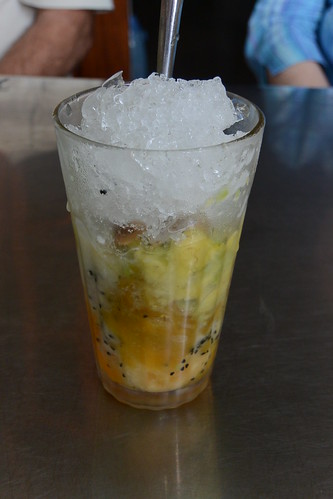 |
| Sinh to trai cay mixed fruit shake with pineapple, jack fruit, avocado, mango, passionfruit, dragon fruit and banana. |
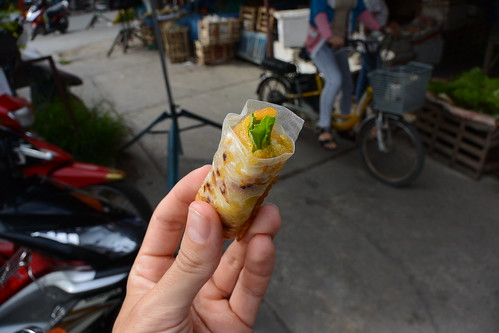 |
| Banh xeo savory sizzling crepes with port, shrimp and bean sprouts (the name is onomatopoeia: "xeo" has a sizzling sound) |
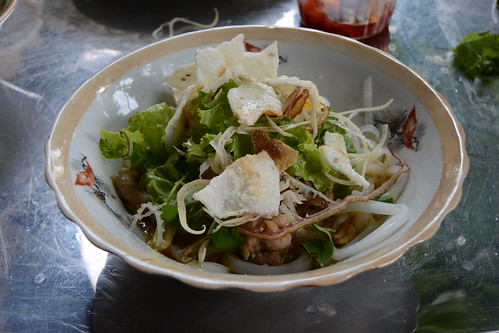 |
| Mi ga chicken noodle soup with herbs and lettuce, crispy chitlins, and lime juice (remember the yin/yang thing with flavors and textures?) |
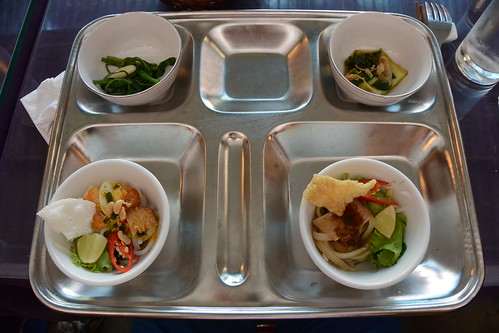 |
| Half of our tastings were in the street; the other half were in tasting rooms in larger rétaurants. They were brought in on these trays. |
 |
| Cau lau Noodle soup with pork, salad leaves, chili, lime and a crisp Thís is a specialty of Hoi An - the noodles used here can't be found anywhere else. |
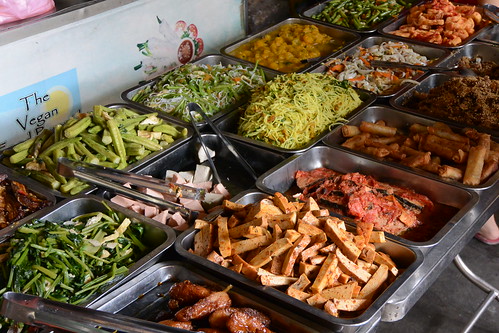 |
| Vegan restaurant We tried the "pork" and "beef", both of which were actually made from soybeans, and both òf which were nearly indisinguishable from the real thing. Also delicious. |
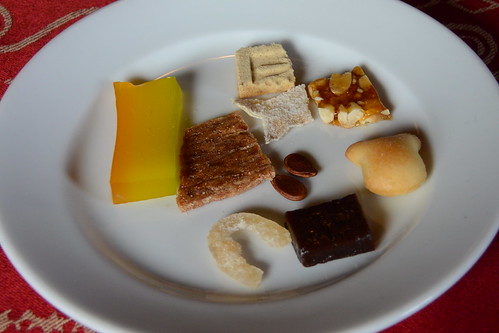 |
| Sweets My favorites were the panda bear cookies (far right), the banana candy (the black square), and the coconut cookie (the brown trapezoid in the middle). |
 |
| Banh suse (golden jelly-like dumpling) Banh it la gai (dark jelly-like dumpling) Both were wrapped in banana leaf and had a nut of some sort in the middle |
 |
| Banh cuon thin rice rolls with pork and minced wood ear mushroom (we had these the first time in Hanoi) |
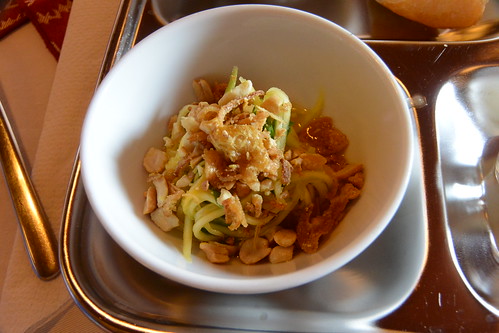 |
| Green mango salad with peanut and fried shallots |
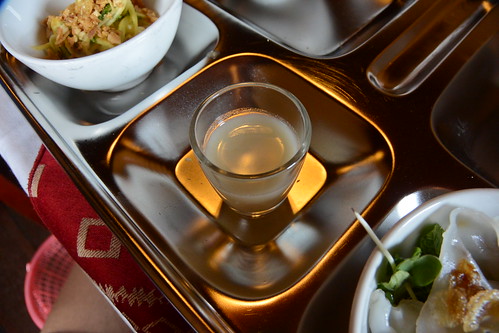 |
| Nen fortified rice wine |
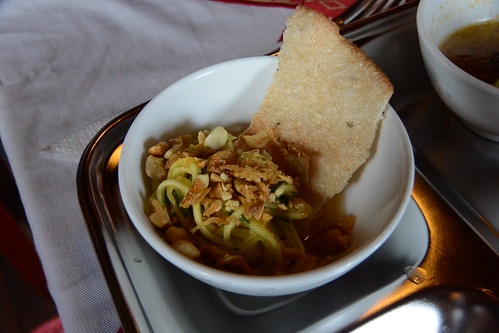 |
| Green mango salad with peanut and fried shallots You eat these salads with a crisp instead of chopsticks or utensiles. |
 |
| Cha gio re spring roll with lattice paper filled with pork, carrot, mushroom and celery |
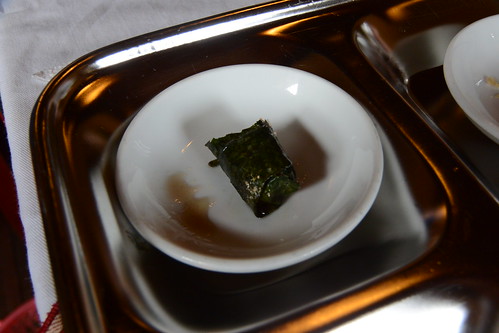 |
| Bo nuong la lot grilled bề rolled with wild betel leaf (the one thing I did not like) |
 |
| Banh beo steamed rice flour dics with dried shrimp filling |
 |
| Ca phe sua da Vietnamese drip-filtered coffee, condensed milk, crushed ice |
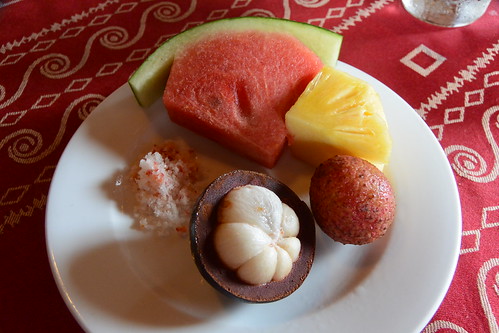 |
| Watermelon, pineapple, lychee and salt with chili flakes (for dipping) |
 |
| Chanh muoi salty preserved lemon drink |
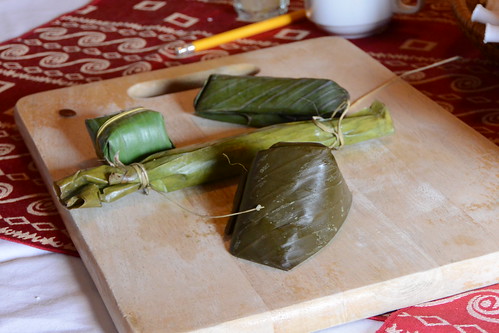 |
| Cha bo and Cha heo Guess what's inside the leaves? |
 |
| Yep, SPAM! Well, the locally made version. SPAM became a huge hit during the war against the Americans. |
 |
| There it ís: beef and pork sausage with pepper cooked in banana leaf. The one on the top right, though (with the pinkish hue), is Nem, a cured ham cooked in banana leaves and guava leaves. |
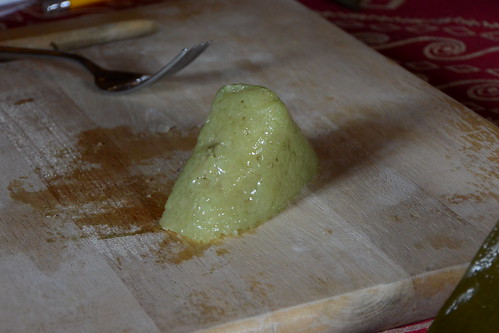 |
| Banh chung square sticky rice cakes with pork and mung bean cooked in banana leaves |
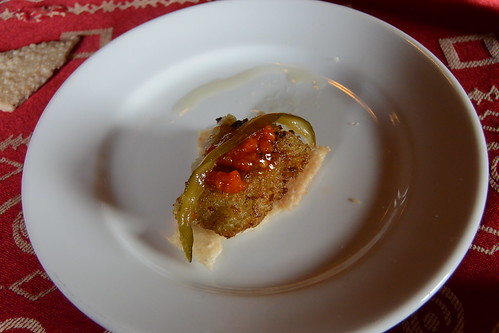 |
| This is how you eat banh chung: on a crisp with chili sauce and a pickled pepper. |
Later that evening, when we were hungry again (many hours later!), we put in practice the principles we had learned. We found a place on the street where many locals were eating and that had tons of messy trash under its tiny plastic tables. The only dish on the menu was cau lau, which we'd learned about on the tour. When it came, we recognized immediately the yin/yang elements and knew to add in the lime juice and chilis before mixing everything up and digging in. It was as if we knew what we were doing!
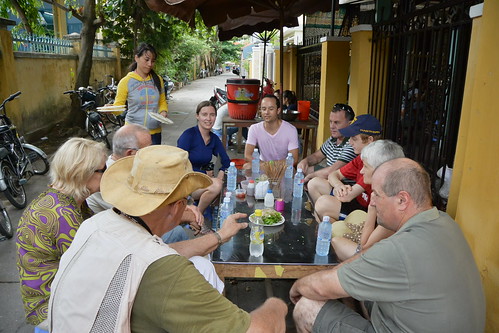
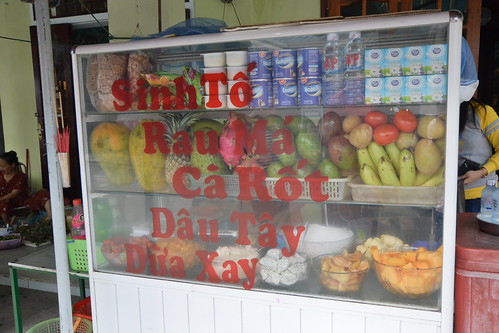


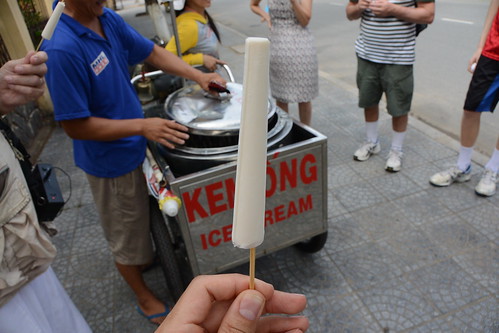
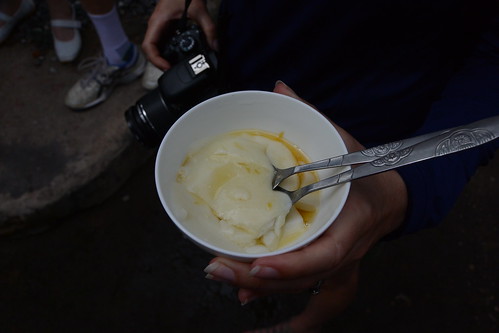
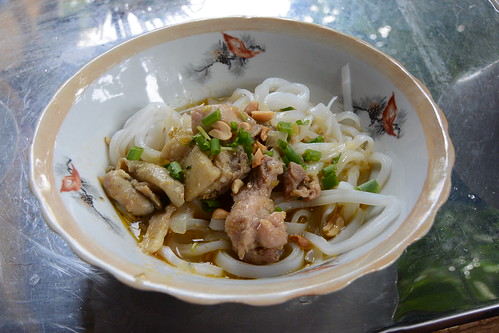
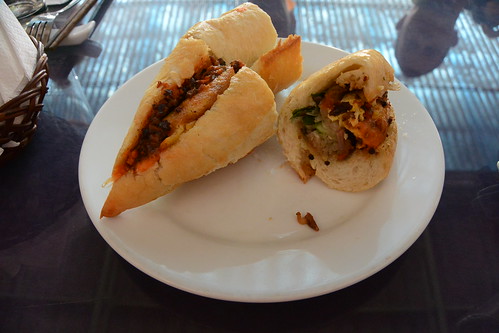
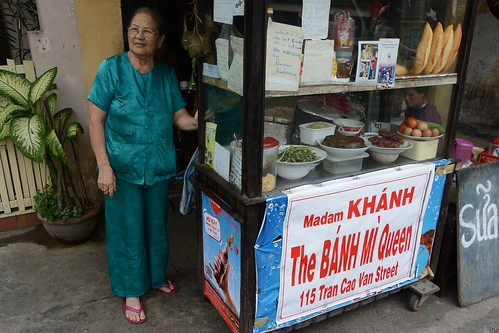
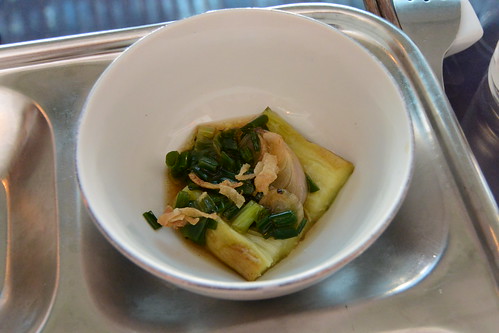
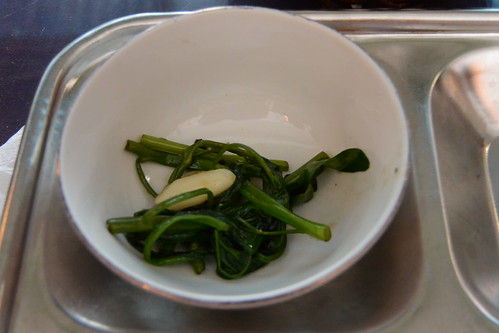
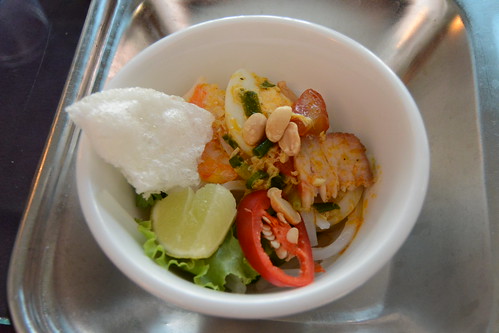
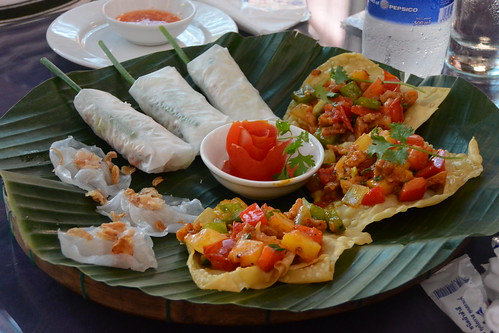
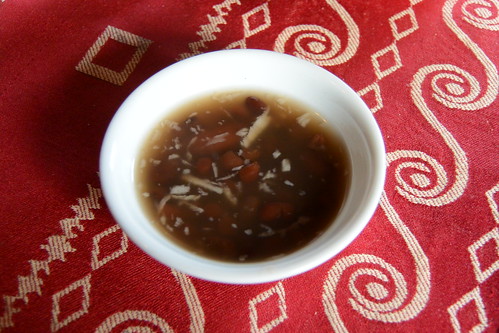
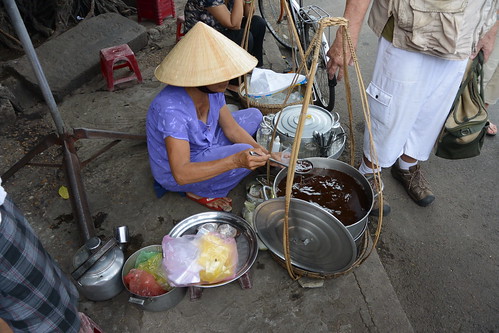
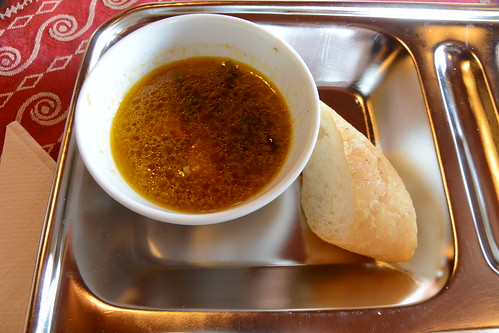

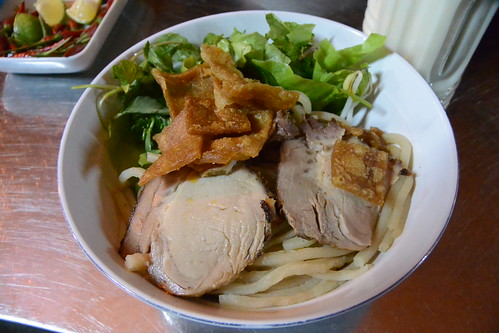
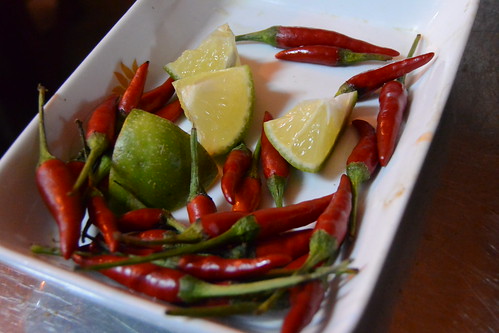
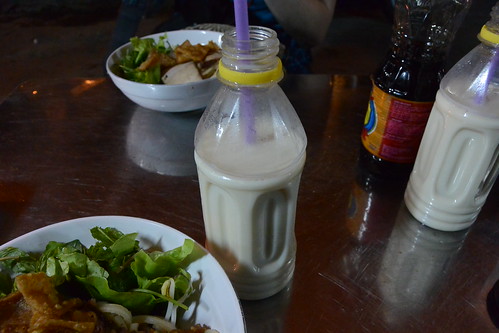
4 comments:
Some of it looks very delicious. Wish I had the aromas to go with it. What an amazing experience. I feel stuffed just looking at all the photos. Oh, if you don't eat things from the river...I thought that's where the worms came from. Lady
So great to know we've given the world SPAM.
I really love Cao Lau- a specialty of Hoi An and I only found it there on my travels in Vietnam. I had a chance to enjoy it in the local market when joining a tour from http://hoianfoodtour.com/ yesterday. It’s served with meat, salad, herbs, crispy rice noodles and sauce. Our tourguides told some amazing secret of Cao Lau. Today, I came back the market and only cost 20,000 VND.Yumy!!!
Oh My God, I think you have eaten all the best in Hoi An. Only one attempt to run a Vespa tour in Hoi An is perfect.
Post a Comment